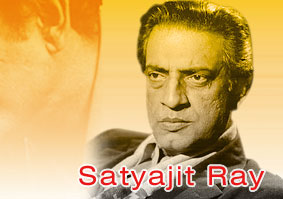Satyajit Ray was born on May 2, 1921 in Calcutta into
a Bengali family of a distinguished cultural lineage. After graduating
from the famous Presidency College of Calcutta, Ray enrolled in the
Visva-Bharati University founded by noted poet Rabindranath Tagore.
During his stint in the Visva-Bharati, Ray's creative faculties were
enriched by the exposure to different nuances of fine arts.
Consequent to the course completion, Satyajit Ray joined advertising
agency D.J. Keymer as a visualiser. After a couple of award-winning
assignments, he joined publishing house Signet Press with the
responsibility of designing cover jackets for books. While the job
itself was an exercise in creativity, more importantly it led to Ray's
first brush with the cream of Bengali literature. He gradually developed
a passion for films and with a few friends founded the Calcutta Film
Society in 1947.
In 1949 Satyajit Ray married his distant cousin Bijoya Das. The same
year French director Jean Renoir came to Calcutta and the great
filmmaker's encouraging words motivated Ray to tread the path of
filmmaking. Next year Ray went to London as D.J. Keymer's art director
and there he got an opportunity to watch Vittorio de Sica's film
'Bicycle Thief.' The film, a neorealist classic, kindled the filmmaker
in Satyajit Ray.
He returned home determined to realize the dream of a film portrayal of
Bibhutibhusan Bandopadhyay's novel Pather Panchali. Despite being dogged
by financial hassles, Ray and his ensemble of amateur crews finally
completed the film and released it in 1955. The film won rave reviews
all over the globe and heralded the arrival of a master filmmaker.
Satyajit Ray made two more films Aparajito (1956) and Apur Sansar (1959)
based on the life cycle of central protagonist Apu. Riding on the crest
massive success and adoration, Ray unleashed a slew of memorable films
such as Jalsagar (1958), Devi (1960), Teen Kanya (1961), Abhijan (1962),
Kanchenjunga (1962), Mahanagar (1963)) and Charulata (1964).
His credentials firmly established now, Satyajit Ray opted for creative
liberty in his later films and dabbled in themes as diverse as fantasy
and historical drama. Some of his prominent films during this period are
Goopy Gyne Bagha Byne (1969), Pratiwandi (1970), Jana Aranya (1975),
crime fiction Sonar Kella (1974), Jai Baba Felunath (1978) and Shatranj
ke Khiladi (1977), his first film in Hindi.
In 1983 a severe heart attack crippled Ray's mobility and his last three
films, Ganashatru, Shakha Proshakha and Agantuk couldn't create the
magic of his earlier films. Satyajit Ray breathed his last on April 23,
1992.







